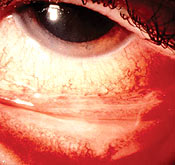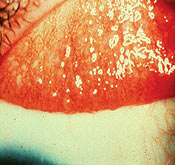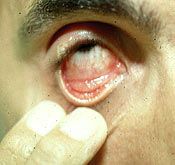History, presentation important keys to diagnosing viral eye disease
Viral eye disease can be diagnosed, treated and managed with a little vigilance from a primary eye care provider, despite the lack of an established treatment protocol, according to practitioners who spoke to Primary Care Optometry News.
In the case of herpetic disease, the history is critical.
“Studies vary, but in general, recurrent herpes simplex eye disease occurs in 50% of patients about every 2 years,” Bruce E. Onofrey, OD, RPh, FAAO, FOGS, director of primary eye care services, Lovelace Medical Center, Albuquerque, N.M., said in an interview. “It is important to carefully question the patient about prior episodes of unilateral, recurrent ocular infections, cold sores or exposure to individuals with active herpetic disease.”
In the case of adenovirus, listen to what the patient says about outbreaks, he cautioned. “Adenovirus, also known in some cases as epidemic keratoconjunctivitis, can be associated with a group outbreak,” Dr. Onofrey said.
Clinical signs/symptoms
A clinician should suspect that an acute red eye is herpes simplex viral in nature if the patient is young and the infection is unilateral, according to Christopher J. Quinn, OD.
As for symptoms, “about two-thirds of patients who have a viral conjunctivitis will also have a tender or palpable preauricular node with a follicular conjunctivitis,” Dr. Onofrey said.
Herpetic patients have a history of prior ocular infection in the same eye. A practitioner should ask the patient if he or she has been “diagnosed with herpes eye disease in the past, because all herpes viruses have properties of both latency and recurrence,” he said.
“A punctate or dendritic keratitis is the most classic sign of herpetic corneal disease, but may not be present in cases of conjunctivitis or blepharoconjunctivitis,” he added.
Adenovirus, on the other hand, is commonly associated with a group outbreak and is usually bilateral in nature. “There’s not usually a history of recurrence,” Dr. Quinn told PCON. “There can be redness, tearing and crusting of the eyelids. Patients often have follicles in the conjunctiva.”
Lab tests can confirm viruses
Cell culturing has been the gold standard for testing for adenovirus.
 |  |
| Adenoviral conjunctivitis with pseudomembrane. Images: Onofrey B | |
 |  |
| Herpes simplex blepharoconjunctivitis. | |
“It’s not a highly practical test because it takes time to get the results,” Dr. Quinn said.
“Then there is Rapid Pathogen Screening’s Adeno Detector, also called a lateral flow immunoassay,” Dr. Onofrey said. “It’s not quite as accurate as a cell culture with antigen antibodies, but it’s approaching that point of sensitivity and specificity.”
Lee J. Raykovicz, OD, director of clinical relations for Rapid Pathogen Screening, told PCON that, according to clinical trial data, sensitivity and specificity were nearly the same when comparing the RPS Adeno Detector with cell culture. “The sensitivity between the RPS Adeno Detector and the cell culture was 89% and 91%, respectively, and the specificity was 94% and 100%, respectively,” he said.
Dr. Raykovicz noted that because the Adeno Detector is a [Clinical Laboratory Improvement Amendments] CLIA-waived test, clinicians must register as a CLIA-waived lab within their state department of health. “This requires a CLIA waiver, and RPS will assist providers in the process,” he said. “The Adeno Detector is simple enough for a nurse or technician to use.”
Dr. Onofrey said he rarely does cell cultures for viral disease.
“I usually diagnose based on clinical evidence,” he said. “I monitor patients for signs of either bilaterality or corneal signs for herpetic disease.”
Developing your clinical acumen is particularly important, as pooled data from several studies showed clinical findings and lab studies to correlate between 40% and 72% of the time, Dr. Raykovicz added.
Steroids and tears
Dr. Onofrey treats his adenoviral patients with a topical steroid administered three times a day with a tapering of the drop over a period of 2 weeks. He also recommends an artificial tear.
“Topical steroids are particularly useful in managing EKC patients with significant conjunctival and corneal inflammation,” Dr. Onofrey said. “It is important to remove inflammatory pseudomembranes and inhibit their formation by utilizing a topical steroid. Be sure to look for membranes on both the upper and lower lids. Untreated, they can lead to conjunctival cicatrization. Steroids also are important in limiting subepithelial infiltrate formation.”
Implementing topical steroids should be done with caution, Dr. Raykovicz said, as their use early in adenovirus infections promotes increased viral shedding and infectivity, according to multiple studies.
Dr. Onofrey said some practitioners also treat adenovirus of the eye with the ocular disinfectant povidone-iodine ophthalmic solution 5%.
“A drop is put into the eye for 1 minute, then rinsed out with saline,” he said. “The eye has to be anesthetized.” A follow-up treatment would include a steroid three to four times a day.
Dr. Onofrey treats herpetic patients depending on the level and type of virus. “For herpes blepharoconjunctivitis, I put the patient on topical acyclovir 5% three times a day for lid lesions. I have them apply Viroptic [trifluridine, Monarch] drops to their eye five times a day until the virus clears, without taper,” he said. “Those who have corneal involvement of epithelial infectious disease are given Viroptic five to six times a day and are put on one of the oral antiviral agents beyond the time that the virus clears the cornea.”
Oral antivirals may include acyclovir 400 mg three times a day, valacyclovir 500 mg twice a day or famciclovir 250 mg two times a day, he said.
Oral therapy has proven efficacy in reducing the recurrence rate in those with stromal keratitis, Dr. Quinn said.
Stay out of contact lenses
The practitioners said patients may be able to resume contact lens wear after several weeks of treatment and after the eyes are completely clear of infection.
“In patients who develop corneal involvement, it can be much, much longer than that,” Dr. Quinn said. “It may be an extended period of time.”
Dr. Raykovicz agreed. “If a patient has a red eye, he or she shouldn’t be wearing a contact lens,” he said.
HSV and refractive surgery
The practitioners said patients with herpes simplex virus inflammations may not be good candidates for laser vision correction.
“It certainly is a relative contraindication,” Dr. Quinn noted. “Extreme caution would be advised.”
For more information
- Bruce E. Onofrey, OD, RPh, FAAO, FOGS, is a member of the PCON Editorial Board. He can be reached at Lovelace at Journal Center, 5150 Journal Center Blvd., NE, Albuquerque, NM 87109; (505) 275-4226; e-mail Eyedoc3@aol.com.
- Christopher J. Quinn, OD, a member of the PCON Editorial Board, can be reached at Omni Eye Services, 485 Route #1, Iselin, NJ 08830; (732) 750-0400; fax: (732) 750-9079; quinn@omnieyeservices.com.
- Lee J. Raykovicz, OD, director of clinical relations for Rapid Pathogen Screening, can be reached at 7227 Delainey Ct., Sarasota, FL 34240; (877) 921-0080; e-mail: raykovicz@rps-tests.com; Web site: www.rps-tests.com.
